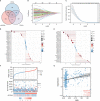Prognostic value of SLC4A4 and its correlation with the microsatellite instability in colorectal cancer
- PMID: 37152025
- PMCID: PMC10154614
- DOI: 10.3389/fonc.2023.1179120
Prognostic value of SLC4A4 and its correlation with the microsatellite instability in colorectal cancer
Abstract
Objective: To explore new biomarkers related to microsatellite instability in order to better predict prognosis and guide medication.
Methods: The "limma" R package was used to identify differentially expressed genes in GSE24514, and then weighted correlation network analysis was used to select key genes. Different cell types in the tumor microenvironment were identified and analyzed by single-cell sequencing, with a Lasso regression model used to screen prognostic variables. Furthermore, the correlation between microsatellite instability and potential prognostic variables was explored, as well as the expression characteristics and clinical characteristics of the prognostic variables in the TCGA, UALCAN, and HPA databases. PCR assay was used to investigate the expression of SLC4A4 in colorectal cancer cell lines. Finally, we further verified the expression of SLC4A4 by immunohistochemistry.
Results: First, 844 differentially expressed genes in GSE24514 were identified. Subsequently, weighted co-expression network analysis (WGCNA) of GSE24514 obtained all the genes significantly associated with microsatellite instability (MSI), a total of 1452. Analysis of GSE166555 single cell sequencing data set yielded 1564 differentially expressed genes. The gene sets obtained from the above three analysis processes were intersected, and 174 genes were finally obtained. The Lasso regression model revealed two potential prognostic genes, TIMP1 and SLC4A4, of which, there was a stronger correlation between microsatellite instability and SLC4A4. The mRNA and protein expression of SLC4A4 was significantly decreased in tumors, and patients with low SLC4A4 expression had a poor prognosis. In addition, SLC4A4 was specifically expressed in epithelial cells. In the microenvironment of colorectal cancer, malignant cells have a strong interaction with different stromal cells. PCR showed that SLC4A4 was significantly down-regulated in colorectal cancer cell lines Caco-2, HCT116 and HT29 compared with normal control NCM460 cell lines. Immunohistochemistry also showed low expression of SLC4A4 in colorectal cancer.
Conclusion: SLC4A4, as a tumor suppressor gene, is significantly downregulated and positively correlated with microsatellite instability, thus it may be combined with microsatellite instability to guide colorectal cancer treatment.
Keywords: Slc4a4; biomarker; colorectal cancer; microsatellite instability; single-cell sequencing.
Copyright © 2023 Rui, Wang, Huang, Xu, Zhou and Zhang.
Conflict of interest statement
The authors declare that the research was conducted in the absence of any commercial or financial relationships that could be construed as a potential conflict of interest.
Figures








Similar articles
-
Identification of key genes for predicting colorectal cancer prognosis by integrated bioinformatics analysis.Oncol Lett. 2020 Jan;19(1):388-398. doi: 10.3892/ol.2019.11068. Epub 2019 Nov 7. Oncol Lett. 2020. PMID: 31897151 Free PMC article.
-
Identification of signatures associated with microsatellite instability and immune characteristics to predict the prognostic risk of colon cancer.Open Med (Wars). 2024 Dec 20;19(1):20241056. doi: 10.1515/med-2024-1056. eCollection 2024. Open Med (Wars). 2024. PMID: 39726813 Free PMC article.
-
Down-regulated Solute Carrier Family 4 Member 4 Predicts Poor Progression in Colorectal Cancer.J Cancer. 2020 Mar 26;11(12):3675-3684. doi: 10.7150/jca.36696. eCollection 2020. J Cancer. 2020. PMID: 32284764 Free PMC article.
-
Is There a Role for Programmed Death Ligand-1 Testing and Immunotherapy in Colorectal Cancer With Microsatellite Instability? Part I-Colorectal Cancer: Microsatellite Instability, Testing, and Clinical Implications.Arch Pathol Lab Med. 2018 Jan;142(1):17-25. doi: 10.5858/arpa.2017-0040-RA. Epub 2017 Nov 16. Arch Pathol Lab Med. 2018. PMID: 29144791 Review.
-
The Clinical Significance of Microsatellite Instability in Precision Treatment.Methods Mol Biol. 2020;2204:33-38. doi: 10.1007/978-1-0716-0904-0_3. Methods Mol Biol. 2020. PMID: 32710312 Review.
Cited by
-
Shared and specific competing endogenous RNAs network mining in four digestive system tumors.Comput Struct Biotechnol J. 2024 Nov 5;23:4271-4287. doi: 10.1016/j.csbj.2024.11.005. eCollection 2024 Dec. Comput Struct Biotechnol J. 2024. PMID: 39669749 Free PMC article.
-
SLC4A4 Moulds the Inflammatory Tumor Microenvironment and Predicts Therapeutic Expectations in Colorectal Cancer.Curr Med Chem. 2025;32(19):3861-3878. doi: 10.2174/0109298673277357231218070812. Curr Med Chem. 2025. PMID: 38310390
-
Study on the Characteristics of Coarse Feeding Tolerance of Ding'an Pigs: Phenotypic and Candidate Genes Identification.Genes (Basel). 2024 May 8;15(5):599. doi: 10.3390/genes15050599. Genes (Basel). 2024. PMID: 38790227 Free PMC article.
-
Targeting SLC4A4: A Novel Approach in Colorectal Cancer Drug Repurposing.Curr Issues Mol Biol. 2025 Jan 20;47(1):67. doi: 10.3390/cimb47010067. Curr Issues Mol Biol. 2025. PMID: 39852182 Free PMC article.
-
ZP3 Expression in Pancreatic Adenocarcinoma: Its Implications for the Prognosis and Therapy.Protein Pept Lett. 2025;32(2):124-138. doi: 10.2174/0109298665350171241204153202. Protein Pept Lett. 2025. PMID: 39791146
References
LinkOut - more resources
Full Text Sources
Other Literature Sources
Research Materials
Miscellaneous

